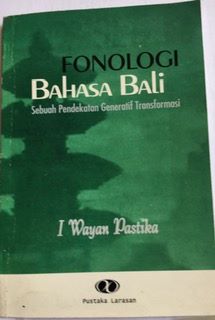
GENERATIVE PHONOLOGY OF BALINESE
I Wayan Pastika
ISBN : 979-3790-07-5 Published : 2005
Abstrak
GENERATIVE PHOLOGY OF BALINESE
I Wayan Pastika
Summary
The segments from Balinese consist of 18 consonant segments, namely / p, b, t, d, c, j, k, g, m, n, ny, ŋ, l, r, w, y, s, and h /, and 6 segments of vowel origin, i.e., e, ə, a, u, and o /. All these original segments were found through the Same Environmental Contrast procedures. The twenty four original segments require 15 distinguishing features to determine their phonetic characteristics.
Balinese has 28 canonical patterns that are found by applying positive BA morpheme requirements. These canonical patterns provide information about the general limitations of the consonant or vocal sequence in the phonological picture of morphemes.
Seventeen sets of two vowels and 23 sets of two consonants are allowed. A series of two vowels can be a series of sheet vowels or a different set of vowels. The seventeen series of two vowels cover: 1) / a-ə /, 2) / ae /, 3) / ai /, 4) / au /, 5) / ao /, 6) / aa /, 7) / ii /, 8) / i-ə /, 9) / iu /, 10) / he /, 11) / io /, 12) / ee /, 13) / uu /, 14) / ua /, 15) / ui /, 16) / ue /, 17) / u-ə /. All of these series are grouped into four if-then conditions. Twenty-three series of consonants include: 1) / mp /, 2) / mb /, 3) / nt /, 4) / nd /, 5) / ø-c /, 6) / ø-j /, 7) / ŋ-k /, 8) / ŋ-g /, 9) / ŋ-s /, 10) / rb /, 11) / rt /, 12) / rd /, 13) / rc /, 14) / rj /, 15) / rs /, 16) / rg /, 17) / rn /, 18) / rm /, 19) / rw /, 20) / ks /, 21) / kt /, 22) / st /, and 23) / tm /. All consonant sequences are grouped into 5 if-then conditions.
The distribution of consonants and vowels is fairly even, except for glotal-fricative / h / which cannot occupy the initial position. The unequal distribution occurs in the final position of morpheme, because the alveo-palatal consonants / c, j, and ny /, semivowels / w and y /, and the middle vowel / ə / cannot occupy this position. An analysis of the morpheme structure requirements produces some clarity of affix identity both singly and in combination. An affix identified by other researchers as N- in this thesis is identified as / ŋ- /, because this morphophoneme is one of the segments from BB, and has the most extensive distribution compared to other nasals in an assimilation process. The change of BA
(phonemic) to BT (phonetic) is translated into 17 phonological rules, namely:
(1) nasal assimilation / ŋ- / (mandatory), (2) obstructive (compulsory)
impulse, (3) minor punctuation / s /, (4) permeation / h / (not required), (5)
permeation / ə / (not compulsory), (6) minor rules of permeation / a /
(optional), (7) addition of [n] (required) , (8) small rules of adding [ŋ]
(required), (9) adding semivowels (not required), (10) adding [ə] (required),
(11) adding syllables (not required), (12) disimilation vowels (not required),
(13) degemination / n / (required), (14) relaxation of vowels (required), (15)
small vowel decreases (not required), (16) small rules of vocal incorporation
(optional), and (17) pressure placement (required).
